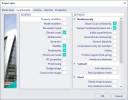Functionality tab
The procedure for setting the parameters is the same as for other project parameters.
SCIA Engineer offers a wide range of capabilities. In order to make the operation of the program as clear and simple as possible, the project settings allow for selection of those features that are needed and required.
The Functionality settings dialogue comprises options that control both the appearance and function of the program. That means that until some advanced feature is selected in this dialogue, the program neither performs the specific task nor even offers it in the menu.
The functionality options are divided into several groups.
Property modifiers
Certain properties of both 1D and 2D members can be modified for the calculation using special attribute called Property modifiers. Properties that can be altered include: stiffness, self weight, mass.
Model modifiers
If ON Absences and Stiffness modifications are available in the project. Certain properties of both 1D and 2D members can be modified per load case for the linear calculation using 1D and 2D stiffness modification add data. Properties that can be altered include: stiffness, self weight.
Parametric input
Advanced users of SCIA Engineer may find it very useful to define some of the program input values as parameters. Parameters, if applied, provide for fast, easy and simple change of e.g. structure dimensions, load values, etc. One single modification of the appropriate parameter leads to automatic regeneration of the model with the new defined value.
Climatic loads
If wind or snow loads are supposed to act on the structure, this functionality option must be set ON.
Mobile loads
If ON, the model of the structure can be subjected to different types of mobile loads.
Dynamics
When ticked the option makes the dynamic analysis features available to the user. The appropriate dynamics-related functions and parameters become available in menus and solver adjustment dialogues.
Modal & harmonic analysis
If this option is ON, modal analysis and dynamic calculation with harmonic loading can be performed.
Seismic spectral analysis
If this option is ON, seismic calculations can be performed.
Dynamic time-history analysis
One or more time-dependant dynamic load cases can be defined with name, mass combination, damping, total time and integration steps. Multiple time-dependant dynamic load functions can be used as modal and basic functions. It is possible to use the results in combination with other (static) load cases for further post-processing.
Stability
This option allows the user to calculate stability analysis.
Nonlinearity
This option controls whether the nonlinear analysis is available in solver options and, therefore, whether the user can perform a nonlinear calculation of his/her problem. The Nonlinearity functionality comprises several sub-items. These sub-items are independent on each other and only some of them may be selected for a particular project.
Beam local nonlinearity
If this option is ON, functions for nonlinear analysis of 1D members are available (e.g. 1D member acting only under compression, etc. may be analysed).
Support nonlinearity/basic soil spring
If this option is ON, functions for nonlinear analysis of supports are available.
Initial imperfections
If this option is ON, functions for introduction of initial deformations before calculation are available.
Geometrical nonlinearity
If this option is ON, functions for geometrically nonlinear calculation are available.
General plasticity
General plastic analysis of 2D members; several material models are available, such as Tresca, Von Mises, Mohr-Coulomb, Drucker-Prager.
Compression-only 2D members
Masonry or plain concrete walls and similar structural elements can be analysed using this option.
Cables
Specific 1D member nonlinearity for the analysis of cables; combines the behaviours tension only, no bending stiffness, initial stress and initial curved geometry.
Friction support/Soil spring
If ON, friction supports may be defined in the model, as well as advanced line soil springs
Membrane elements
Thin plates can be calculated as membranes.
Structural model
This option enables the user to use two different "shapes" in his/her model. Normally, the calculation model is created and used for calculations, evaluation of results and design and checking to a particular technical standard.
In addition, the user may also define a structural shape that is derived from the calculation shape and can be used for impressive drawings and is also useful during the design of connections.
IFC properties
This option is useful when the project is imported through the IFC format. The architect may have provided his/her model with some requirements such as required fire resistance, fact that the member transfers no load, etc.
Prestressing
This option provides for calculation of prestressing.
Bridge design
Load combinations
Handling of specific EN code combinations for bridges
Construction stages
With this option activated, the project will represent modelling of construction stages appearing during the execution of the structure.
Subsoil
The Subsoil functionality represents an important and powerful feature of the program especially if the interaction of the analysed structure with its subsoil must be taken into account. The Subsoil functionality is always ON. The following subfeatures can be enabled:
Soil interaction
The interaction between the structure and subsoil can be analysed using the structure-soil interaction module.
Pad foundations can be checked using the relevant code regulations.
Steel
This option enables nonlinear analysis of steel frame structures with plastic hinges.
Fire resistance checks
The type of fire resistance for steel members may be defined after this option has been selected.
Steel connections
This option opens possibility for the definition and check of steel connections.
Scaffolding
Enables the user to design and check scaffoldings.
Aluminium
Scaffolding
Enables the user to design and check aluminium scaffoldings.
Concrete
RC material nonlinearity
The material nonlinearity can be taken into account in the nonlinear analysis of reinforced concrete structures with 1D elements and/or 2D elements.

